12 April 2021
11790
0
3 out of 5
Neck pain is a very common problem. After all, according to medical statistics, more than 70% of people experience this periodically or regularly. Nevertheless, there are many reasons that can provoke pain of varying intensity in the neck. Most of them lie in diseases of the cervical spine. At the same time, the characteristics of pain, its localization, and the nature of other existing symptoms are important diagnostic signs that help to correctly determine what triggered them and prescribe treatment appropriate to the situation. It is very important to identify the disease causing pain in the neck as early as possible and take measures to eliminate it, since they can cause severe complications, including disability.
Why does neck pain occur?
Pain in the neck and head occurs due to:
- Partial spinal dysfunction associated with vertebral artery syndrome (circulatory disorders when moving the head).
- Vascular diseases of a systemic type (chronic alcohol or drug intoxication, metabolic diseases).
- Osteochondrosis of the cervical spine (degenerative and dystrophic pathology).
- Traumatic damage to the head and spine.
- Vegeto-dystonic syndrome.
With such ailments, in addition to pain, memory impairment, irritability, insomnia, anxiety, fear, dizziness, and a crunch in the neck appear. To accurately determine the diagnosis, you need to see a doctor.
Causes of painful symptoms
If a patient complains that he has a neck pain and nausea, and also feels dizzy (when walking or at rest), doctors first need to understand the causes of the condition and make the correct diagnosis.
Osteochondrosis of the cervical spine
The most common cause of dizziness, accompanied by nausea and pain, is osteochondrosis of the cervical spine. During his life, a person constantly makes various movements, which means his body is almost constantly under stress. The spine absorbs the load, and over the years this leads to the fact that its individual elements wear out and gradually begin to lose their function. The cartilaginous structures (intervertebral discs) that are present in the cervical and other parts of the spine gradually lose moisture and become fragile and thin. This is called osteochondrosis. The vertebrae and intervertebral discs altered by osteochondrosis begin to irritate the paired vertebral artery, which supplies the brain, hence dizziness (together with nausea). Neck pain is caused by the fact that the distance between the spinal disc and the vertebral body becomes smaller, and they gradually begin to compress the spinal nerves.
Vascular diseases
If your neck hurts and nausea appears, these symptoms may be associated with problems of the vascular system. A general disruption of the functioning of blood vessels leads to the fact that blood moves through them at a reduced speed, and in some segments the blood even stagnates. Consequently, normal nutrition of all organs and systems of the human body ceases. For poor blood supply to the brain, dizziness and nausea, headaches that radiate to the cervical region are quite typical.
Metabolic diseases
Neck pain and nausea are symptoms that can occur due to a general metabolic disorder in the human body. Such diseases include diabetes mellitus, hypertension, atherosclerosis and other pathologies that lead to the gradual accumulation of harmful substances in the human body.
Traumatic disorders of the spine and head
The cause of neck pain, instability in movement or at rest can also be a spinal injury. If the structure of the vertebrae is damaged (especially the most fragile ones, which are located in the cervical region), every movement of a person can be accompanied by pain. Dizziness occurs due to the fact that damaged vertebral structures interfere with normal blood supply to the brain.
Vegetative-dystonic syndrome
A separate group of causes that provoke dizziness and neck pain includes vegetative-vascular dystonia.
. This is a complex disease that is associated with a violation of the vascular tone of the autonomic nervous system. Dizziness and neck pain are symptoms that appear along with irregular heartbeat, pressure surges, pale face, fainting, etc.
Diagnostics
For neck pain, the doctor first performs an examination, interviews the patient and evaluates his lifestyle. Then instrumental examination methods are carried out:
- Radiography is a procedure for examining the spine by projecting x-rays onto film.
- CT scan. During this event, the source of pain under the doctor’s palpation is scanned and displayed as a three-dimensional image on special equipment.
- Magnetic resonance imaging. With its help, images of the affected area of the spine are created in various projections using a powerful magnetic field, after which a diagnosis can be made.
Examination methods
The most correct decision on what to do if you have a headache, back of the head and neck is to contact for a full diagnosis. Even an experienced specialist will not be able to make an accurate diagnosis based only on an initial examination, so additional examinations are prescribed to understand the overall picture of the disease. They may include a number of specific techniques aimed at studying the condition of the vertebrae, muscles and blood vessels:
- rheoencephalography - study of cerebral vessels;
- MRI is the most informative way to examine the neck and head, especially if tumors and injuries are suspected;
- X-ray – used to exclude injuries to the cervical spine.
At the Clinical Brain Institute, you can undergo a complete examination, which will determine the cause of persistent headaches. Accurate, modern equipment is located here, thanks to which all examinations are carried out within the center. Experienced specialists will be able to decipher the indicators and prescribe an effective treatment regimen.
With dizziness
Why do you feel dizzy and have neck pain? To determine the cause, you need to understand the structure of the spine in the cervical region. In this part, a bundle of blood vessels enters through the vertebrae, and due to the curvature, uneven pressure appears. As a result, with deformation, an increase or decrease in intracranial pressure is observed. That's why my neck hurts and I feel dizzy. Soreness is usually on 1 side.
In addition to dizziness and neck pain, there may be increased weather sensitivity, redness of the white membrane of the eye, swelling around the eyes, and nosebleeds. The mobility of the cervical spine also worsens, myositis may appear with the likelihood of becoming chronic.
This type of compression occurs due to improper function of different spinal sections. Uniform compression of blood vessels leads to a decrease in oxygen supply to the brain. This can be seen in speech disorders, a feeling of weakness, the appearance of apathy, sleep disturbance, which is a sign of decreased brain functionality.
In addition to neck pain and dizziness, you are also likely to experience:
- spasms in the shoulder girdle;
- the appearance of a lump on the seventh cervical vertebra;
- radiating pain into the arm.
The causes of the condition include injuries. Pain in the neck, back of the head and dizziness are signs of pathological mobility of the cervical vertebrae, vertebral artery syndrome, and osteochondrosis.
In many patients, such symptoms occur precisely due to osteochondrosis. Provoking factors that cause severe neck pain and dizziness include physical overexertion, hypothermia, injuries, and a monotonous posture that does not change for a long time. Manifestations of osteochondrosis include morning dizziness, which lasts throughout the day. It is also possible to experience a headache, a feeling of weakness, lethargy, drowsiness, a crunch in the neck, changes in the sensitivity of the hands, sweating, nausea, hearing and vision impairment.
Results of the study of the symptom of dizziness
For many years, a group of otoneurologists at the Scientific Center of Neurology of the Russian Academy of Medical Sciences has been collecting and analyzing patterns of dizziness attacks, associated diseases and conditions, as well as the possibilities of their treatment. The main direction of research was cerebral vascular diseases that develop as an accompaniment of arterial hypertension, atherosclerosis, deformation of the spinal arteries, etc.
It was found that attacks of dizziness vary in duration over a fairly wide range. In approximately 15% of cases, their duration is only a few seconds. Most patients (up to 77%) experience dizziness for several minutes or even several hours. For other patients, this sensation may accompany them for several days in a row. Almost always (in 97.5% of patients) the onset of an attack correlates with a change in the tilt of the head or body.
Along with dizziness in vascular diseases, other similar symptoms are observed: instability while walking (up to 80% of patients), memory impairment (up to 90% of patients), headaches (up to 90%), a feeling of noise in the head (about 50%), rapid onset of feeling tired (95% of patients).
In approximately half of the cases, a hereditary burden of diseases of the circulatory system was identified: the parents or close relatives of the patients suffered from arterial hypertension, vascular diseases of the brain, or coronary heart disease. In approximately two-thirds of cases, vestibulopathy could be assumed due to the constitution of the body: manifestations of increased sensitivity of the vestibular apparatus were present in them from early childhood, which manifested itself in intolerance to carousels and swings, motion sickness while traveling on a bus or car, etc.
Dizziness of vascular origin leads to a deterioration in the quality of life, a significant decrease in the performance and social adaptation of patients. According to the study, due to constant dizziness, the ability to work noticeably worsened in 87% of the patients examined, and all patients, without exception, noted a limited ability to perform household duties. In 37% of patients, dizziness was so severe that it led to temporary disability, and in many cases this condition occurred more than once.
Neck and head pain
There are many pathologies that cause pain in the back of the neck and dizziness. Diseases leading to such symptoms include myogelosis, neck migraine, neck muscle strain, cervical osteochondrosis, damage to the occipital nerve, and cervical spondylosis.
With myogelosis, severe pain in the back of the head, dizziness, stiffness of the shoulder girdle, and muscle swelling appear. Cervical spondylosis is accompanied by pain in the head or neck, pain that is not associated with physical activity. Pain in the upper third of the shoulder is likely, radiating to the ears or eyes, as well as discomfort when rotating the head.
Migraine-like pain in the neck occurs in the form of intense pain in the head and temples. There may be a feeling of pain in the eyes, as well as visual and auditory dysfunction. Due to overstrain of the neck muscles, pain appears in the back and in the head. Such symptoms occur when a static posture persists for a long time. With this pathology, a pressing, constant pain appears in the forehead or on the back of the head. It may grow.
If your neck, back of your head hurts, or you feel dizzy, this may be due to neuralgia. Severe pain attacks appear that radiate to the back, jaw or ears when moving the head. Cervical lumbago is a pathology of the spine in which the neck hurts and such sensations radiate to the head. It appears when receptor structures in the spinal nerve are compressed.
Therapy
If your back, neck hurts, or you feel dizzy, then you need to take this problem seriously and, if pathologies appear, urgently visit a neurologist, therapist or orthopedist. Treatment will relieve pain, relax neck muscles and eliminate provoking causes. Often, discomfort is relieved with painkillers, anti-inflammatory drugs and muscle relaxants.
If your neck hurts or you feel dizzy, what should you do? Doctors prescribe combination drugs with paracetamol and acetylsalicylic acid. These are “Askofen”, “Aquacitramon”, “Pamol”, “Perfalgan”. Paracetamol does not cause irritation of the gastric mucosa, but it is harmful to the liver in large quantities, and acetylsalicylic acid improves blood flow by reducing platelet aggregation, but stomach irritation may also occur.
If you feel dizzy or have a sore neck between the shoulder blades, non-steroidal anti-inflammatory drugs may be prescribed. These are Ibuprofen and Diclofenac. These drugs eliminate pain caused by inflammation, but prolonged use can lead to gastritis, ulcers, and gastric bleeding.
Other effective remedies
In addition to medications, recovery comes from physiotherapy and reflexology. Massage and manual therapy have beneficial effects. The method of exposure should be chosen by a doctor, since the causes of pain may require different therapy.
If your neck hurts, you feel dizzy, or feel nauseous, choose reflexology methods:
- acupuncture;
- pharmacopuncture;
- vacuum therapy.
After pain has been reduced, recommendations for physical therapy and exercise are provided. The effectiveness of therapy depends on an individual approach and complementary treatment procedures.
Exercise therapy and massage
Physiotherapists and massage therapists help eliminate pain in the back of the head. Electrophoresis can improve blood flow in tired muscles. A warming massage also relieves discomfort. When pain occurs due to osteochondrosis, physical therapy helps.
To relieve pain, you need to stretch and relax the neck muscles:
- You must sit on a hard seat with a backrest, but do not touch it with your back.
- You need to take your head in your palms, pressing a little with your thumbs on the cheekbones, and with the other on the back of your head.
- With your head tilted back, you need to apply a little pressure with your fingers.
- You need to stay in this position for about 6 seconds, and then relax and touch the back.
- The exercise is performed several times.
Chiropractors allow you to relax your back muscles. If there is pain in the cervical spine or the back of the head, you need to get permission from your doctor to perform manual therapy. The specialist will prescribe the necessary vitamins and warming gels, which will speed up blood flow.
Headache due to pathology of the neck muscles
“I have a headache, they said it’s from my neck. Osteochondrosis on x-ray..."
(From complaints at the reception).
Headache with cervical osteochondrosis is a fairly common phenomenon. There is a term - “cervicogenic headache” , which suggests the initiating role of pathology of the cervical spine in the origin of pain in the head, which can either be provoked or reduced, or pass, partially or completely, under the influence of influences on the cervical spine (movements). , manipulation, dry needle injections or administration of anesthetics).
Osteochondrosis is a set of degenerative changes in the cervical spine and the body’s reaction to them. They develop over a long time.
At various stages of the pathological process, various factors play a leading role in the development of pain: herniation and protrusion of intervertebral discs, with subsequent compression of the nerve roots or spinal cord, narrowing of the spinal canal and/or intervertebral foramina, instability of the vertebrae, leading to excessive displacement relative to each other during movement, pathology of intervertebral (facet) joints, ligaments and muscles.
It is the headaches associated with muscle pathology that will be discussed in this article. Due to the vastness of the topic, as an example we will consider headache with myofascial syndrome of the splenius neck muscle.
The term myofascial pain syndrome (MPPS) refers to a complex of motor, sensory and autonomic symptoms caused by activation of myofascial trigger points. The latter are an irritated area of skeletal muscle with a hypersensitive node located in it, detectable by touch, located in a compacted muscle bundle. The presence of a reflected phenomenon is mandatory, i.e. pain, muscle spasms, narrowing or dilation of blood vessels, the appearance of which is associated with the trigger point, but manifests itself at some distance from it, and having a strictly defined localization, rarely coinciding with the projection of a peripheral nerve or dermatome segment. There are active and latent (inactive, hidden) points. Impact on an active trigger point intensifies the patient’s characteristic complaints, while the presence of a latent one is manifested by local muscle tension, stiffness, increased fatigue, and a feeling of numbness.
In the presence of MFPS of the splenius neck muscle, patients usually complain of unilateral pain in the neck, head and eye, decreased visual acuity, blurred vision, photophobia, swelling, mainly of the periorbital region, and stiffness in the cervical spine. Moreover, the pain spreads from the occipital region to the eye socket, passing through the skull, as if through it. The trigger (painful, triggering) point is located just above the middle of the neck, approximately at a distance of two to two and a half fingers' width from the midline.
Factors that contribute to the occurrence of pain include: working at a desk, during which the head is constantly turned to one side, sleeping on an uncomfortable pillow, postural disorders such as scoliosis, stooping, physical work in a draft, etc.
The main methods of treatment are: mandatory elimination of provoking factors, manual therapy, massage, physical therapy, reflexology, physiotherapy (laser, ultrasound), injection with medicinal mixtures.
The method and combination of treatment methods is determined by the attending physician after the final diagnosis has been established. Indications and contraindications are taken into account
Self-exercises are usually given only after the acute pain has been relieved. The doctor must be sure that the patient has understood the order of their implementation.
The author is a neurologist, chiropractor Dmitry Gennadievich Tsyro.
Dangerous symptoms
Some signs require special attention. This applies to:
- Intense “thundering” pain, which may indicate a cerebral hemorrhage.
- For the first time, strong compression appeared in the back of the head. This may be a symptom of an intracranial tumor or temporal arteritis.
- Increasing sensations over 2-3 weeks resulting from large brain tumors.
- Noticeable disturbances in consciousness.
- Unexpected unusual pain during physical activity that increases intracranial pressure.
It is not possible to make a diagnosis on your own. It is better to consult a doctor if unusual symptoms appear. This way, the causes will be identified and effective treatment will be prescribed.
Prevention
An important point in the prevention of ailments that cause neck pain and dizziness is the development and use of correct movements. But experts recommend adhering to a number of preventive measures:
- It is necessary to avoid sudden movements when bending the body.
- Periodically (every half hour) you need to change the position of the body while maintaining a monotonous position for a long time.
- It is necessary to maintain correct posture.
- Avoid overstraining the intervertebral discs.
- You should not lift weights exceeding 10 kg.
- You should develop a habit of physical exercise that strengthens your back muscles.
- When lifting heavy objects, a special corset is used.
- The natural physiological curves of the spine should be preserved.
- Avoid overcooling and creating drafts in the room.
- Rational nutrition and hardening of the body are useful.
What do experts think?
The best prevention of pain is a healthy lifestyle. You should not sit at the computer a lot, and if you need to work for a long time, you should have a chair with a high, supportive back. This will allow you to correctly distribute the load on the spine. It is also important to ensure proper rest. Sleep should last at least 6-8 hours. The best therapeutic prevention would be an orthopedic pillow and mattress purchased from a certified manufacturer.
Moderate physical activity is of great importance. With the help of daily gymnastic exercises for the neck and other parts of the spine, the musculoskeletal system is strengthened. In addition, the joints become strong, elastic, and resilient.
To avoid pain in the neck, head, and back of the head, you should not consume large quantities of fatty, smoked, and salty foods. Food should contain mineral supplements and vitamins. You also need to eliminate bad habits - smoking, alcoholic drinks. Every year you need to undergo preventive examinations with local therapists or specialized specialists.
Thus, neck pain and dizziness arise from various causes. Only a doctor can identify them. It is necessary to follow the recommendations of a specialist in order to quickly improve your condition.
How to treat headaches and neck pain
The treatment method for neck pain and dizziness directly depends on what caused the appearance of such symptoms. Doctors may prescribe painkillers, anti-inflammatory drugs (tablets or gels for topical use). Medicines are also prescribed to restore blood flow, blood pressure, and metabolism. In some cases, physiotherapeutic procedures, massage, and exercise therapy are effective. Any treatment must be under the supervision of a physician. Sometimes, if there is no effect, it can be adjusted or supplemented. To get help from a qualified doctor, contact the Energo clinic. This is where specialists work who have extensive experience in treating spinal injuries, vascular, metabolic and other disorders of the human body.









